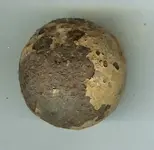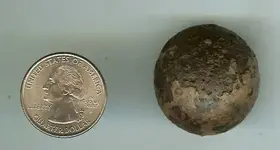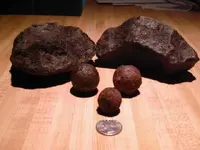"Guess-timating" by the photo with the quarter, the mystery-ball seem to be a little bit under 1.25 inches in diameter. If that is accurate, the closest match from the US Ordnance Department "Shot Tables" at:
http://www.civilwarartillery.com/shottables.htm
the closest match for your iron ball is a 6-pounder Canister ball (at 1.14-to-1.17 inches in diameter.
So get hold of a precision Caliper/Micrometer and get an exact measurement of your mystery-ball's diameter, to see if is the proper size to be a canister-ball.
By the way, grapeshot and canister are NOT the same thing. Grapeshot ammo was for Navy use, and canister was for Army use. Grapeshot contained nine large-sized iron balls, in order to tear up an enemy ship's masts, rigging, and sails. Canister contained dozens of smaller iron balls, to "shotgun" massed-infantry attacks.
Before closing this post I should mention that even civil-war soldiers themselves very frequently mis-named grapeshot balls and canister balls. For example, Gettysburg eyewitness combat reports say "the air was filled with a storm of grape and canister." But in actuality, the official Ordnance Department Reports show that no grapeshot ammunition was used at Gettysburg.
Nonetheless, because infantry-soldiers so often mis-named grape and canister balls, modern civil-war buffs (and relic-hunters) continue to confuse grape and canister balls. So here's a rule-of-thumb:
Army cannon (6, 12, and 24-pounder) canister-balls tend to be from 1.14" to 1.87 inches in diameter, and
Navy cannon (24, 32, 42-pounder and up) grapeshot-balls tend to be 2.6" diameter (and up).
Regards,
TheCannonballGuy (Pete George)





 I can say it's a metal ball.
I can say it's a metal ball.
